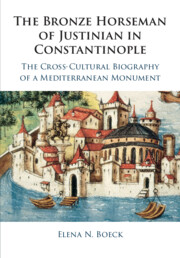 The Bronze Horseman of Justinian in Constantinople
The Bronze Horseman of Justinian in Constantinople Published online by Cambridge University Press: 08 April 2021
The bronze horseman issued an ominous warning in 1317. The fall of the horseman’s orb caused grave concerns for the emperor Andronikos II (r. 1282–1328). Andronikos II had this renowned imperial monument restored in 1317. He ensured that the bronze horseman would remain standing as an embodiment of Palaiologan imperial renewal. Yet Byzantine sources are silent about this important event. A range of evidence suggests that the Byzantine historian Nikephoros Gregoras intentionally underplayed the incident. By protectively demurring about the actual object that had fallen – the symbol of sovereignty and dominion – he concealed contemporary anxieties behind a rhetorical façade of successful restoration. The horseman’s insecure grasp of the orb and the orb’s inexplicable mobility became a flash point for international concerns about the future of Byzantium. Audiences as far away from Constantinople as London, Cordoba, and Moscow became preoccupied with the orb. This chapter reveals that the presence or absence of the orb became a key element in the reception of the monument and the evaluation of Constantinople’s future. Palaiologan rulers repeatedly spent enormous sums of money to ensure that the orb remained in the bronze horseman's hand.
To save this book to your Kindle, first ensure no-reply@cambridge.org is added to your Approved Personal Document E-mail List under your Personal Document Settings on the Manage Your Content and Devices page of your Amazon account. Then enter the ‘name’ part of your Kindle email address below. Find out more about saving to your Kindle.
Note you can select to save to either the @free.kindle.com or @kindle.com variations. ‘@free.kindle.com’ emails are free but can only be saved to your device when it is connected to wi-fi. ‘@kindle.com’ emails can be delivered even when you are not connected to wi-fi, but note that service fees apply.
Find out more about the Kindle Personal Document Service.
To save content items to your account, please confirm that you agree to abide by our usage policies. If this is the first time you use this feature, you will be asked to authorise Cambridge Core to connect with your account. Find out more about saving content to Dropbox.
To save content items to your account, please confirm that you agree to abide by our usage policies. If this is the first time you use this feature, you will be asked to authorise Cambridge Core to connect with your account. Find out more about saving content to Google Drive.